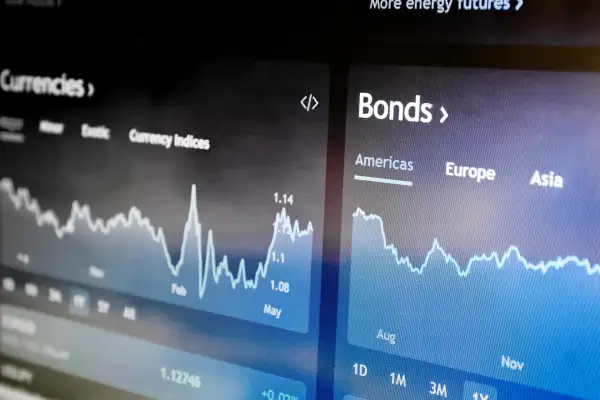Is a Recession Coming Soon? This Bond Market Indicator Is Flashing Red
Money is not a client of any investment adviser featured on this page. The information provided on this page is for educational purposes only and is not intended as investment advice. Money does not offer advisory services.

Bonds usually don't get as much attention as stocks. But now that a a key indicator in the bond market is signaling a possible recession, bond are getting their fair share of headlines.
That's because the yield curve, an indicator analysts use to measure economic outlook, is starting to look wonky. The yield curve is a graph of bond yields — typically, yields on Treasurys issued by the U.S. government — that plots the time horizon on the x axis and the yields on the y axis.
Bonds with a longer time to maturity, like the 10-year U.S. Treasury, tend to have higher yields than those with a shorter amount of time to maturity, like the 3-month U.S. Treasury. It makes sense: If you're willing to lend your money to the government for a longer period of time, you can expect to get paid more.
Yet at the end of March, the 2-year Treasury yield was trading higher than the 10-year yield for the first time since 2019, marking what's called a "yield inversion." The yield curve inverted again last week. The last six times this part of the yield curve inverted, a recession followed 18 months later on average, according to LPL Financial.
Here's what you need to know about this bond market indicator.
Bonds are debt obligations issued by a company or government, and typically, the longer you're willing to lend your money for, the higher you'll be compensating for lending that money. Because of this, when the yield curve is "normal," a security with a longer time until maturity, like a 30-year bond, will offer a higher interest rate than a 10-year bond.
But when long-term yields fall below short-term yields, the yield curve inverts. That inversion tends to reflect investors' uncertainty about the future of the economy.
What does an inverted yield curve mean for the economy?
Certain parts of the yield curve hold more weight for analysts than others. Historically, when 3-month Treasury bill yields are higher than 10-year bond yields, some time in the next one to two years there has been a recession, says Kathy Jones, chief fixed income strategist at the Schwab Center for Financial Research.
Experts also tend to watch the 2-year to 10-year yields, which inverted in recent weeks.
"The curve inversion should be signaling a slowdown is coming," Jones says. But of course, it's not a lock a recession is imminent. "This isn't a precise science."
Now it's up to the Federal Reserve, and how aggressive it wants to be in raising interest rates to tamp down inflation, a practice known as tightening. The Fed recently announced plans to raise its benchmark rate by a quarter percentage point, bringing it into the 0.25%-0.5% range after keeping rates near zero since the start of the pandemic. Fed Chair Jerome Powell has also said that the Fed is prepared to raise rates even more aggressively, if deemed necessary, to fight inflation.
"The tightening tends to go a bit too far and tips the economy into a recession," Jones adds. Rising interest rates make it more expensive for consumers and companies to borrow money, which typically reduces demand for goods and services and cools the economy. But if inflation and energy prices come down, for example, the Fed may slow the pace of rate increases as it wouldn't feel as much urgency, Jones says.
After the COVID-19 crisis devastated the economy in 2020, the country started to recover last year much faster than initially anticipated, as we can see from soaring inflation.
Then in late 2021, Powell indicated that the Fed thought it should start to raise rates, which started the process of sending yields higher as the market anticipated stronger growth and more inflation, Jones says.
On top of this, the war in Ukraine has pushed up prices even more, especially energy costs. The Fed, in turn, is having to react even more strongly.
"The Fed has pivoted hard from worrying about employment and the economy and disinflation to moving to try to get ahead of the inflation," says Matt Eagan, a portfolio manger and co-head of the full discretion team at Loomis Sayles. "They were woefully behind the curve on that so they're playing catch up now."
Should investors prepare for a recession?
Like Jones says, a yield inversion doesn't mean we should immediately buckle down and get ready for a recession. But it does signal likely distress ahead.
“We don’t think recession is in the cards for this year," Lawrence Gillum, fixed income strategist at LPL Financial, said in a recent blog post. “If the Fed follows through with the expected rate hikes however — a big if — we’re likely going to see the 3 month/ 10 year close to inversion by the end of the year, which would likely mean recession could be a 2023/2024 event.”
As Mark Haefele, chief investment officer at UBS, pointed out in a recent note to clients, there is often a long lag between inversions and recessions. Of the last 10 times the U.S. curve inverted, there were three times that there was no recession for the next two years. Plus, the timing is uncertain. On average, recessions started 21 months after an inversion, but they ranged from nine to 34 months, Haefele added.
What's more, the 3-month/10-year yield curve isn't inverted right now. It isn't until a majority of points in the yield curve invert that a recession in the next two years becomes "increasingly inevitable," Bespoke Investment Group wrote in a recent note to clients.
What does this mean for your portfolio?
The usual investing advice still applies: The best strategy is to have a strong investing plan with a diversified portfolio in place and stick to it, even when you get spooked.
Financial experts recommend having a mix of stocks, bonds and cash, with the allocation to each depending on your financial situation, goals and risk tolerance. For example, Rob Williams, managing director of financial planning, retirement income and wealth management at Charles Schwab recently told Money that for the average person with an investment horizon of 10 years or more, an 80% allocation of stocks and stock funds (both U.S. and international) is the most likely path to wealth.
But if you want to take some action right now, you can de-risk your portfolio a bit, Jones says. That doesn't mean selling out of all your stocks or bonds, but perhaps pulling some money out of more speculative investments, like cryptocurrency. When excess money is rolling around the markets, it tends to go into speculative assets, but they're also first to underperform when that liquidity comes out.
Fixed income investors may also want to start locking in intermediate- to long-term yields, since chances are yields will be lower by the time the Fed finishes the process of raising rates, Jones says.
"We actually think it's an opportunity for income investors to add a little bit of exposure," she adds.
If you're holding cash on the sidelines but a 2-year Treasury is going to pay you 2.5%, why not consider the latter? Investment-grade corporate bonds specifically are currently an area of opportunity for investors, Jones adds. You can find information on various corporate bond funds via Morningstar.
More from Money:
A 'Rude Awakening' Is Coming for Millions of New Investors
The Fed Is Hiking Interest Rates. Should That Change Your Investment Strategy?

